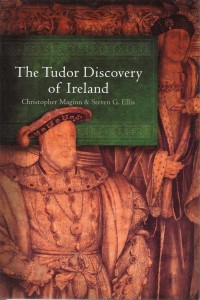THE TUDOR DISCOVERY OF IRELAND
Published in Book Reviews, Issue 6 (November/December 2015), Reviews, Volume 23Reviewed by David Heffernan
Has a volume of 70 ‘reform’ treatises on Tudor Ireland forthcoming from the Irish Manuscripts Commission.

By the late fifteenth century English power in Ireland had declined dramatically. The civil wars in England had seen little attention paid to Ireland, and knowledge of the political state, economy and geography of Ireland was very limited in England by the inception of the Tudor dynasty in 1485. Christopher Maginn and Steven Ellis’s The Tudor discovery of Ireland examines how the first two Tudor sovereigns, Henry VII and Henry VIII, rediscovered Ireland, preparing the way for the conquest of the country during the sixteenth century. Their book presents an extended essay on how this occurred between 1485 and 1540 (pp 111–86). They argue that it was a twofold process. First, it involved the composition of treatises by officials in Ireland, providing information for king and ministers in England. Second, it entailed the periodic sending of missions to Ireland to obtain information and attempt reforms of the English lordship. In conjunction these two processes led to a significant acquisition of knowledge about Ireland by the 1530s.
This analytical essay, however, comprises just the final third of Maginn and Ellis’s book. The first two thirds are concerned with a previously unpublished collection of eight early Tudor treatises on Ireland derived from a volume found at Hatfield House amongst the papers of the Elizabethan statesman William Cecil, Lord Burghley. The ‘Hatfield Compendium’ was probably compiled late in the reign of Henry VIII. The first third of the book presents an extended analysis of the individual documents in the compendium (pp 25–66), while the second third presents the actual text (pp 67–109). This arrangement, as Maginn himself notes in the preface, is wholly unconventional. Yet in an age when publishers are unfortunately far too concerned with streamlined texts, Maginn and Ellis are to be praised for producing, and Four Courts Press for publishing, a book that prioritises textual studies above a more conventional arrangement.
The publishing of the Hatfield Compendium brings a number of treatises into print for the first time and presents more accurate or detailed copies of texts previously in print. Of particular note is an accurate copy of Patrick Finglas’s ‘A Breviat of the Conquest of Ireland and of the Decay of the Same’, for which scholars have long relied on a wholly distorted copy printed in the mid-eighteenth century. No treatise on Ireland was more widely read in the sixteenth century than Finglas’s and an accurate version in print is timely. The final third of the book, charting the Tudor discovery and attempted ‘reform’ of Ireland from 1485 to 1540, is convincing in arguing for the period as one of knowledge acquisition. Moreover, in considering both the reigns of Henry VII and Henry VIII, the volume is refreshing in transcending the fifteenth/sixteenth-century divide, as so few historians do. The sections dealing with the late 1530s, for which we have a much greater documentary record, are rushed, however, and don’t quite do justice to, for instance, the records available for the commission into Irish affairs of 1537.
From an interpretative perspective, The Tudor discovery makes an important contribution to the ongoing debate on the nature of Tudor ‘reform’ in Ireland. Maginn and Ellis posit that the word was used as an equivalent of ‘restore’. When writers wrote of ‘reforming’ Ireland they were expressing a desire to ‘restore’ the English lordship to the power exercised at its height during the late thirteenth century. Thus to ‘reform’ Ireland meant to use any method, military conquest included, to ‘restore’ English power. This distinction is welcome and moves beyond the erroneous inference in studies of Tudor Ireland produced from the 1970s to the 1990s that ‘reform’ was a policy approach in binary opposition to military ‘conquest’. Nevertheless, Maginn and Ellis’s supposition is fine only for the time-frame encapsulated by their book. By the late Henrician period there was already a breakdown in what officials in Ireland conceived the term to mean, and by the end of the century ‘reform’ was being used in a wide variety of ways. Given the elasticity of the term, the ‘reform’ debate will go on.
Some criticism could be made of the treatment of individual treatises in the study. For instance, the most significant extant tract written on Ireland in the 1520s, ‘A Discourse of the Cause of the Evil State of Ireland’, is briefly examined in a paragraph and then dismissed as having had no immediate impact on policy. But this ignores its importance in proposing the bulk of the ‘surrender and regrant’ scheme, outlining a programme of military conquest similar to that eventually engaged in by the Tudors and predicting many of the economic and social problems that would ensue from stationing a large crown garrison in Ireland. While the ‘Discourse’ might not have had an immediate impact on policy, it is nevertheless of significance that individuals were writing about these issues at this time. Maginn and Ellis might also have asked why, if it was inconsequential, is the ‘Discourse’ found amongst the papers of a prominent early Jacobean minister?
These limited gripes aside, The Tudor discovery is a welcome contribution to the historiography of Tudor Ireland. Not only does it present well-edited copies of a number of early Tudor treatises on Ireland but it also makes a significant contribution to the ‘reform’ debate. Above all, it successfully demonstrates that before the Tudors conquered Ireland they had to ‘discover’ it.


















